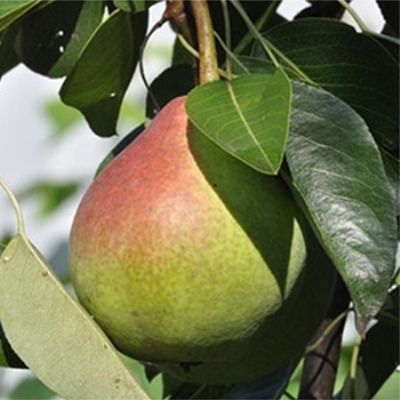
- Authors: A.M. Ulyanischeva (Rossoshanskaya zonal experimental gardening station)
- Name synonyms: Favorite Klappa x Bere winter Michurina
- Year of approval: 1999
- Fruit weight, g: 154-230
- Ripening terms: autumn
- Fruit picking time: in the first half of September
- Appointment: universal
- Growth type: vigorous
- Yield: high
- Transportability: high
When choosing pear varieties for growing in the country, many gardeners are guided by the ripening time of the fruits. The early ones are suitable for consumption, taste good, but are not stored. Autumn varieties can be eaten and canned as they are dense. An excellent representative of late varieties is Tatyana's pear.
Description of the variety
Summer residents rarely grow pears, mistakenly considering them to be capricious in their care. When choosing a variety, you need to take into account the features of the area, personal needs. Breeders are developing many new varieties with a variety of characteristics.
The main properties of the Tatiana variety:
skeletal branches grow at an acute angle;
the crown is narrow pyramidal at the beginning of growth, more spreading during fruiting;
self-fertile tree;
leaves are large, round at the base, with a twisted top;
fruiting occurs 6 years after planting;
good frost resistance;
annual fruiting;
flowers of a white shade of medium size, collected in inflorescences of 6 pieces;
high resistance to disease.
Among the disadvantages are the size of the pear. The tree grows tall, which makes harvesting and pruning difficult.
Fruit characteristics
The Tatyana variety has large fruits with a beautiful smooth skin of a golden yellow color, with a red blurry spot on the side. The pulp is tender, soft, juicy. Ripening occurs in early or mid-September. The average weight of fruits is from 154 to 230 g, they are symmetrical, with a characteristic shape. You can harvest the fruits until December, they do not fall from the branches even when they are fully ripe. The fruits lie well, retain their attractive appearance and taste for up to 3 months, do not deteriorate during long-term transportation.
Taste qualities
The fruit of the Tatiana pear variety has a dessert taste - a pronounced sweetness with a slight sourness. It contains a lot of vitamins. The sugar level reaches 10.5%. The fruits are well suited for fresh consumption, making desserts, compotes, canning.
Ripening and fruiting
Fruiting is annual in the Tatiana variety. Breeders recommend harvesting 10 days before the expected date of full ripening of the fruits. The maturity of maturation can be identified by the following signs:
fruits are not firmly attached to the branches;
the fruit has a characteristic varietal coloration;
aroma and taste specific to the variety appeared;
the fruit pulp has become soft.
If the ripe harvest is late, the fruits will have a mealy taste, and the storage time of the fruits may be reduced. To acquire a dessert taste and long-term storage of fruits, they must be removed from the branches in a timely manner. Although they can hang on the tree for a long time.

Yield
The yield of the variety is high. During the first fruiting, it is 144 kg / ha.With proper care, the yield further increases to 154 c / ha.
Landing
It is better to plant a pear in early spring or late autumn. The slight movement of the sap during these periods will allow the tree to take root better. A large space is required for the pear because the tree will grow tall with a wide crown. The Tatyana variety has a negative attitude towards flooding, therefore, water drainage should be provided in advance if there is such a problem on the site.
For planting, you need to dig a hole 80 cm deep, 70x70 cm in size.Pour drainage to the bottom, a little soil mixture and insert a stake. It will be a support for a young tree. Fertilizer must be applied before planting. For one pit, you should prepare 2 buckets of humus, 60 g of superphosphate, 50 g of potassium salt.
Next, you need to water the prepared hole well, put a seedling near the peg. Gently sprinkle with earth, leaving the root collar 5-6 cm above the soil surface. Slightly compact the root zone, pour again with warm water. Tie the peg to the seedling, mulch in the near-trunk circle. You can use rotted manure, humus. Care must be taken to ensure that fertilizers do not come into contact with the pear tree.


Growing and care
For good survival, seedlings must be watered weekly. One tree requires 1 bucket of water. To prevent root decay, the trunk circle must be constantly loosened. When planting pears in the northern regions for the winter, the seedling must be covered with burlap or spruce branches. This will save a young tree from severe frosts and pests. But in the spring, such a shelter must be removed even before the onset of heat, in order to prevent the seedling from rotting.
Pear watering should be weekly in the amount of 2-3 buckets per year of life. With a moisture deficit, the tree will begin to shed its leaves, the fruits will dry out. In this case, it is necessary to assess the weather conditions. During rainy weather, watering is reduced, during dry summers, watering is increased.
The tree must be pruned regularly for sanitary purposes only. The formation of the crown occurs independently. For the rest, caring for a pear of the Tatyana variety does not differ from other varieties.




Like any other fruit trees, the pear needs protection from various diseases and pests.When planting a pear on your site, you need to know in advance what diseases you should beware of. To successfully carry out the struggle, it is necessary first to correctly identify the cause of the problem. It is important to distinguish signs of disease from manifestations of the presence of insects, mites, caterpillars and other types of pests.





































































